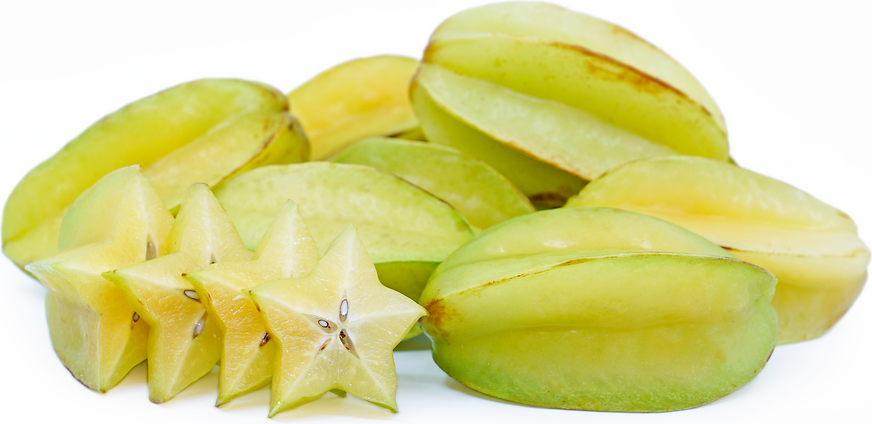


Carambola
Estimated Inventory, lb : 0
This item was last sold on : 12/16/22
Description/Taste
Carambolas are curious-looking fruits that grow on short trunked, densely branched, evergreen trees. They appear along branches and near the leaf joints following small, red stemmed, lilac and purple flowers. The fruits are oblong, maturing from a dark or light green to an orangey-yellow and have 5 (sometimes 6) ribs, or wings that are sometimes tipped with green. They range in size from 6 to 15 centimeters long and up to 9 centimeters wide. Beneath the thin and waxy skin is a yellow flesh that is juicy and crisp when fully ripe. Immature fruits are sour. When cut lengthwise into slices the resulting shape is that of a star. Most fruits will contain up to 12 tiny, flat, brown seeds. Ripe fruits will have a honeyed, tropical aroma, as well as sweet-tart tasting notes of plum and grape. The entire fruit is edible including skin and seeds.
Seasons/Availability
Carambolas are available year-round in tropical regions, and in the late summer through early winter in subtropical areas.
Current Facts
Carambolas, more commonly known in the United States as Star fruit, are scientifically classified as Averrhoa carambola. The fruits have a long history in the Americas, but have their origins in Southeast Asia. The word ‘carambola’ was adopted by the Portuguese, who were the first Europeans to encounter the fruit while in India, where the Malay word was used. The name originally comes from the Sanskrit word for the 5-angled fruit, “karmaranga” meaning “food appetizer”. For this reason, they are referred to as Carambola in many Spanish and Portuguese speaking countries, as well as in southern Florida where the fruits have a short season. The fruits are known as Carambola and Belimbing in their native Indonesia and Carambolier in France, as well as Five Corner fruit in Australia and Five Finger fruit in Guyana. Carambolas contain small amounts of oxalic acid which can exacerbate issues for people with weak or compromised kidneys. Though there are many different cultivars of Carambola, there are two distinct types: a wild type that tends to be smaller, green, sour, and contains more oxalic acid; the other, a cultivated, sweeter type, that is typically larger and more uniform in shape.
Nutritional Value
Carambolas are rich in vitamin C, with one serving giving you half your daily recommended intake of the beneficial nutrient. It is also a good source of fiber and a great source of vitamin K. Carambolas contain vitamin A, carotenes and B-complex vitamins. They are rich in antioxidant flavonoids and folate, and also contain minerals like potassium, phosphorus, zinc and iron. Unripe fruits contain high amounts of oxalic acid, and can be detrimental to those with kidney disease or taking statin drugs.
Applications
Carambolas can be eaten fresh, sliced into stars, or juiced. The sliced fruits have an aesthetically pleasing appearance and are often used as garnish for salads or drinks. Carambola juice can be blended with other tropical fruit juices or can be used for making cocktails and sangria. The fruit can be baked in pies, pastries, tarts and cakes. In Malaysia, they are stewed along with apples, sugar and cloves. Sour or slightly under-ripe Carambolas are best for jams and candying, and in Thailand they are salted and pickled. Young, green fruits are used to make relishes or chutneys. Ripe fruit is dried in Jamaica, concentrating the sugars and preserving for future use. Carambolas pair well with poultry, fish and shrimp. They can be used in marinades, sauces and braising liquids. Store ripe, unwashed fruit in the refrigerator for up to a month. At room temperature, some Carambola varieties will keep for up to two weeks.
Ethnic/Cultural Info
In Brazil, the juice of the Carambola is popular as a refreshing drink and thirst quencher. It is also used medicinally as a diuretic and for those with kidney or bladder problems. The juice of the Carambola is used to treat eczema. In India, the juice is used to counteract fevers and to relieve hangovers. In Chinese medicine, it is used as a cooling agent and appetite stimulant.
Geography/History
Carambolas are believed to be native to Malaysia, known as the Moluccas or Spice Islands. They have been grown in Indonesia and southern China for centuries. The Portuguese discovered the fruit when colonizing India just after the turn of the 16th century. From there, Carambolas traveled with Portuguese explorers to South America and Africa, where the fruit has grown since and spread to nearby regions. Carl Linnaeus was the first to name and record information about the star-shaped fruit. They appeared in his Species Plantarum published in 1753. The genus name, Averrhoa, was given to the fruit trees after a Spanish philosopher and physician known as Averroes. His real name was Ibn-Ruschd, and he lived during the 12th century in Cordoba, Spain. Linneaus adopted the genus name from its common name, a nod to the Portuguese that found the fruit in India. Carambolas were introduced to Florida in the mid-1800s, likely from South America or the Caribbean. The tropical fruits are cultivated for export worldwide, and are sometimes waxed to protect them during shipping, extend storage and preserve the nutrient value of the fruit. In Hawaii and in subtropical Florida and Southern California in the United States, locally grown fruits may be spotted seasonally at farmers markets.
Recipe Ideas
Recipes that include Carambola. One
| Snacking in Sneakers |
|
Spinach and Starfruit Smoothie |

















